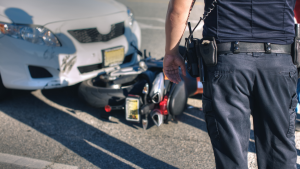Have you ever watched a crime show and wondered how they always manage to catch the criminal? The answer is simple: forensic evidence.
The Lyceum programme in Criminal Justice delves deep into forensic science which has revolutionised criminal investigations, providing crucial evidence that can make or break a case. In this blog post, we dive into the role of forensic evidence in criminal trials and explore why it is so important in solving crimes. So buckle up and get ready to learn about the fascinating world of forensics.
What is forensic evidence?
Forensic evidence often plays a critical role in criminal trials, providing valuable insight into the circumstances of a crime. It involves the application of scientific methods and principles to the investigation of crime and can include fingerprints, DNA, bloodstains, fibres or other trace evidence.
By analysing this evidence, forensic scientists can often link a suspect to a crime scene or provide other important information that can help solve a case. In many cases, forensic evidence is essential to securing a conviction. For example, DNA analysis can provide strong proof of guilt in rape and murder cases. Similarly, fingerprints can be crucial in identifying burglars or robbers.
In some cases though, forensic evidence may not be enough to secure a conviction on its own. This is often the case when there are no eyewitnesses to the crime. In such cases, prosecutors may need to rely on circumstantial evidence or confessions to make their case. Nonetheless, even in these situations, forensic evidence can still be important in building a strong case against the accused.
The role of forensic evidence in the criminal justice system
Forensic evidence plays a vital role in the criminal justice system. It can be used to help convict the guilty and exonerate the innocent. When properly collected and analysed, forensic evidence can provide invaluable information that can make or break a case.
In many instances, forensic evidence is the only physical evidence linking a suspect to a crime. This means that it can be extremely important in getting a conviction. However, collecting and analysing forensic evidence is not always easy and it can be expensive. Therefore, prosecutors must carefully weigh the costs and benefits of using forensic evidence before deciding whether or not to pursue it in a particular case.
When used correctly, forensic evidence can be an extremely powerful tool for bringing criminals to justice. It should be used wisely, however, as it can also be misused if not handled correctly.
How does forensic evidence help prove guilt or innocence?
Forensic evidence can be used to establish time of death, identify the weapon used in a crime or place a suspect at the scene of a crime. In some cases, however, forensic evidence can be inconclusive. For example, DNA evidence can only show that a suspect was present at a crime scene but cannot prove that they committed the crime. However, when used in conjunction with other forms of evidence, such as eyewitness testimony or video footage, forensic evidence can be very powerful in proving guilt or innocence.
Types of forensic evidence used in trials
DNA, fingerprints and ballistics are all common types of forensic evidence used in criminal trials. However, there are many other types of forensic evidence that can be used to help convict a person of a crime.
One type of forensic evidence that is often used in trials is handwriting analysis. This type of analysis can be used to match a person’s handwriting to a sample of writing found at the crime scene. This can be helpful in cases where the perpetrator wrote a note or left a signature at the scene of the crime.
Another type of forensic evidence that is often used in criminal trials is tool mark analysis. This type of analysis can be used to match a tool mark found at the crime scene to a particular tool. This can be helpful in cases where the perpetrator left a tool mark on the victim or on some object at the crime scene.
Shoeprints can often provide investigators with valuable information about the perpetrator. For example, if the perpetrator was wearing shoes with certain tread patterns, this information can be used to try and track down the individual.
Challenges with forensic evidence in trials
There are a number of challenges that can arise when using forensic evidence in criminal trials. One of the most common is ensuring that the evidence is admissible in court. This can be a challenge if the evidence was not collected or handled properly, as it may be deemed inadmissible. Another challenge is making sure that the jury understands the significance of the evidence and how it applies to the case. This can be difficult if the evidence is complicated or technical in nature. Additionally, there is always the potential for human error when dealing with forensic evidence, which could lead to inaccurate results.
Conclusion
Forensic evidence can be a powerful tool and is able to provide decisive proof in criminal trials. However, the importance and implications of relying on forensic evidence requires careful consideration to ensure fair and accurate outcomes. It is, therefore, crucial that courts carefully weigh both the pros and cons of using such evidence when striving for impartiality and the search for truth.



